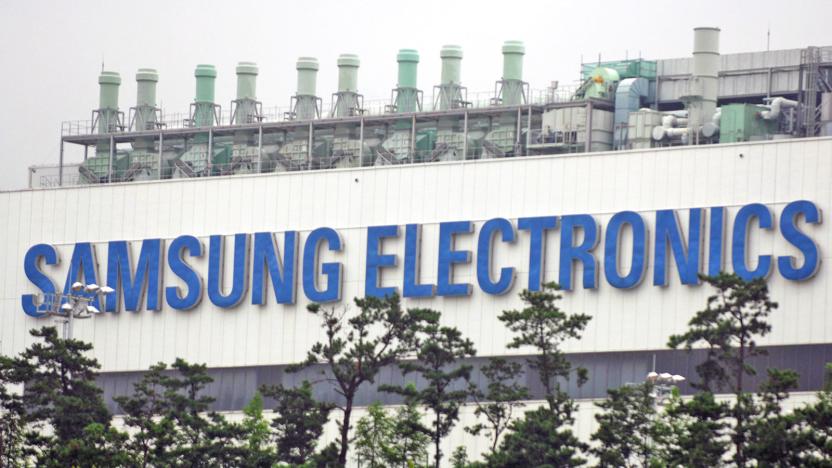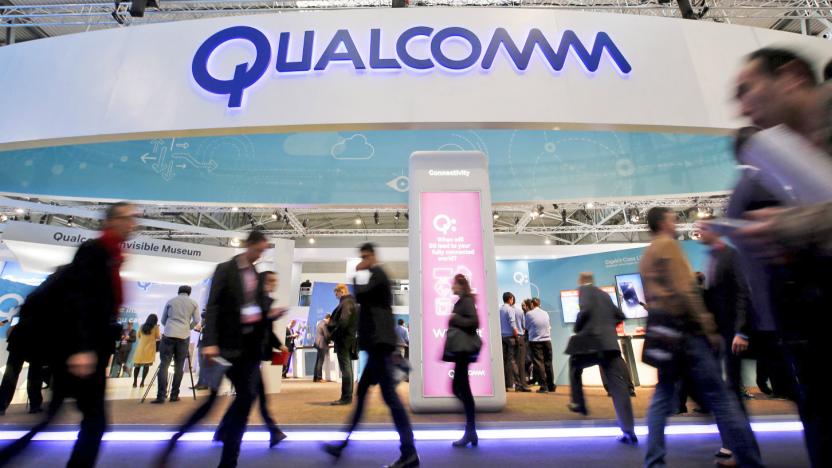systemonchip
Latest

Qualcomm launches its first platform made for robots
Qualcomm's interest in robots is definitely more than a passing fancy. It just unveiled RB3, its first all-encompassing platform for robotics. The part is based on last year's Snapdragon 845 system-on-a-chip but is "highly optimized" for drones and other automatons, including AI and sensor processing, support for private LTE networks and tight security. More importantly, it's flexible. Companies can customize it to their heart's content if they're not happy with the off-the-shelf hardware, and choose an OS like Linux or Robot Operating System.

Samsung starts building 10-nanometer processors
Chip companies are battling Moore's Law tooth and nail, but Samsung says it's the first to start building processors using a 10-nanometer process, ahead of Intel and others. To put that into scale, the transistors will be just 50 times the size of a silicon atom, which is around 0.2 nanometers across. Samsung didn't say who it's building the system-on-chip for, but Korea's Electronic Times says it has an exclusive deal to build Qualcomm's next-gen Snapdragon 830 processors using 10-nanometer tech.

Qualcomm's Snapdragon 821 is its fastest processor yet
Qualcomm has revealed the Snapdragon 821, a mobile processor that's around 10 percent faster than its current performance champ, the Snapdragon 820. However, it's not a replacement for that chip, which is used in high-end phones like the Samsung Galaxy S7 Edge, HTC 10 and Sony Xperia X Performance. Rather, "the 821 is designed to complement and extend the competitive strengths" of its current tech, Qualcomm says. In other words, it'll function as an interim chip for high-end devices until the next-gen processor comes along.

Intel's 14nm tablet processors are leaner, meaner and finally here
Intel isn't just coming to CES with fifth-generation Core processors for traditional PCs -- it has big news for the tablet crowd, too. The company is now delivering its first 14-nanometer Atom system on a chip, previously nicknamed Cherry Trail. The new processor should be both faster and offer more battery life than the Bay Trail-based Atoms you see today, thanks in part to both the more efficient manufacturing process and a big leap forward in graphics. Cherry Trail is using the same basic video architecture as Intel's other new CPUs (Bay Trail relied on 2012-era tech), so you'll have a better chance of playing 3D games and high-resolution videos on your tablet without hiccups.

AMD plays both sides of the CPU wars with chips that use the same socket
Typically, you can't reuse many parts when you switch processor technologies; if you change chips, you change the entire motherboard at the same time. That won't be true for AMD in the future, though. It's working on a common chip framework, Project Skybridge, that will let 2015-era ARM and x86 system-on-chip processors share the same pin layout. In other words, a basic motherboard design could handle both CPU types.

NVIDIA to license graphics tech to other companies, starting with Kepler
To use NVIDIA's graphics technology, you've typically had to buy gadgets using NVIDIA chips -- good for the company's bottom line, but not for influencing the industry as a whole. The firm is expanding its ambition today with plans to license some of that technology on a broader scale. Beginning with the Kepler architecture, other firms can use NVIDIA's GPU cores and graphics-related patents for their own processors and chipsets. The deal could affect a wide range of hardware, but it mostly pits NVIDIA against the likes of Imagination Technologies: a system-on-chip designer could integrate a Logan-based GPU instead of the PowerVR series, for example. While it will be some time before third-party silicon ships with NVIDIA inside, it's already clear that the company's in-house design is now just one part of a larger strategy.

Intel launches Atom CE5300-based storage platform with multiple streams, smart scaling
There's been more than a few Atom-based storage servers. Most of them either have to lean on the same Atom processors you'd usually get with nettops, though, which makes them less than ideal for media tasks than a chip dedicated to the job. Intel has just launched a new platform that might be a better fit for home network storage. New NAS arrays from Asustor, Synology, Thecus and others (none yet pictured here) all revolve around a dual-core Atom CE5300 system-on-chip that's better-optimized for media processing duties: it can stream video across the network to multiple devices at once, and can automatically downscale video to accommodate smaller screens. The small chip contributes to a relatively small price at the same time, with NAS boxes starting around $299. Not everyone can suddenly justify a dedicated media server in the home just because the CE5300 is an option, but those that do may at least get more for their money.

Intel reveals Quad-Core, LTE-capable mobile chips are on the way
Intel's curious decision to shun the US and release Medfield-powered smartphones in India, China, Russia and the UK might be because of those countries' underdeveloped levels of LTE. Marketing chief Sumeet Syal told TechCrunch that its current-generation x86 system-on-chip won't support the standard, but a modem solution will arrive at the end of the year -- with production ramping up in 2013. He also let slip to the site that a replacement dual-core platform will arrive shortly, claiming they'll benefit from Intel's hyper threading know-how. Syal said that Santa Clara is "comfortable" with its progress just months after entering the smartphone space but declined to discuss numbers -- for which we'll have to wait for the Q3 earnings call in October to find out how well (or not) Intel's mobile ambitions are going.

Samsung spending $4 billion to renovate Austin chip factory
Premiership footballers will be weeping in envy at the way Samsung's been spending its cash this month. After splashing $822 million on a Korean R&D center, it's now chucking $4 billion to renovate its semiconductor factory in Austin, Texas. The cash will be used to increase production on system-on-chip products used in a wide variety of smartphones and tablets, presumably to cope with future demand. It's not clear if this investment is in addition to the $1 billion it was raising in January to add a new SOC and OLED line to the same facility, but it's certainly a good time to be living in Texas, right now.

Marvell PXA988, PXA986 chips support 3G for China, the world without reinventing the wheel (or phone)
Whenever we see a smartphone optimized for China Mobile's TD-SCDMA 3G, it usually represents one of two things: it's either a China-specific variant of a phone we already know, or it's a local-only model that's unlikely to ever travel abroad. Marvell has just unveiled a new mobile processor platform that could allow for a lot more globetrotting with those basic designs. The PXA988 is limited to China Mobile's technology for data, but its PXA986 doppelganger can fit the same slot to offer regular HSPA+ 3G without forcing phone makers back to the drawing board. Both run on a dual-core, 1.2GHz ARM Cortex-A9 at their heart -- nothing exciting in mid-2012, although they're well-enough equipped to capture 1080p video and tout extras like NFC. Only test samples exist today, but there's a chance we'll soon see phone designs that are just as much at home in Berlin as they are in Beijing.

Intel porting Jelly Bean to its Atom architecture, is in no hurry to tell you when it's done
Intel has revealed that it's working on bringing Jelly Bean to its low-power Atom architecture. In an email to PC World, company rep Suzy Greenberg confirmed the project was ongoing, but didn't offer a timeline as to when the latest flavor of Google's mobile OS would arrive on a device. It's the same story regarding when Ice Cream Sandwich would turn up on Medfield-powered devices like the San Diego and its brethren. The report also pours cold water on hopes for Clover Trail powered Android gear -- saying that it's pencilled in as a Windows 8-only platform.

Project Moonshot take two: HP's low-power Gemini servers let go of ARM's Calxeda for Intel's Centerton
Last we'd heard of HP's Project Moonshot, that effort to create low-energy servers was set to ride on the back of the Calxeda SoC. But for the rollout of its production-ready "Gemini" models, the company's changed tack, replacing the previously announced ARM chips for Intel's Centerton. Why the sudden swap? Well, it seems that new Atom processor delivers the same energy-sipping promise of its predecessor, while also adding 64-bit support, a broader software ecosystem, error correcting code memory and hardware virtualization. That's all well and good, but when you boil it down to layman's terms, HP's really just angling for the ultimate in efficiency and it plans to do that by providing these compact servers in "a [smaller] footprint" than currently available setups. The system's still not quite ready for primetime consumption, given its very recent public outing, however, demo units are in the pipeline, with a planned launch for the end of 2012. If this sort of back-end geekery gets your blood flowing, feel free to hit up the official presser after the break.

Newport Media claims tiniest, lowest-power 802.11n WiFi chip yet, smartphones get a little less thirsty
Cellular chipsets get all the love these days, but it's WiFi that's still the most ubiquitous -- and often the most consistent drain on the battery. Newport Media might have that last problem solved through its new NMC1000 chip. The part is billed as the lowest-power 802.11n wireless system-on-a-chip you'll find, and potentially a big help to smartphones and other devices that lean heavily on a wire-free existence. At just 2.5mm (0.1 inches) square, the equally record-setting size should also please device makers trying to squeeze wireless into an exceptionally tiny footprint. If you're as excited about the prospect of WiFi everywhere as Newport's Stock Photography Woman above appears to be, you can get more details below and expect full-scale production in the fall.

Qualcomm hires former AMD CTO, makes 'em pay for dropping mobile
Qualcomm is hiring AMD's former CTO Eric Demers to help the company produce a blockbuster mobile graphics chip. It needs the silicon for its big push for smartphone dominance (and tablets running Windows RT) in the face of strong competition from Imagination Technologies' Series 6 PowerVR and NVIDIA's Tegra 3. Demers' first job will be to merge Qualcomm's in-house Adreno team with ATI's Imageon mobile graphics chip team, which AMD flogged off for $65 million back in 2009 -- a move Sunnyvale is probably regretting now that it too is trying to get its hardware into mobile devices, unless it included a do-over clause in the sales contract.

iPad 3 logic board with 'A5X' chip purportedly snapped by Mr. Not-so-Blurrycam
Well, if it looks real, sounds real and is halfway logical, we probably should distrust it all the more. Yes, it's the time when all the rumors, photoshops and general hysteria around Apple's next slab reaches its apex. The photo above was grabbed by the steady hand of sas126, a blurrycam snapper in name only, and posted to Chinese site Weiphone, purporting to be the logic board for the iPad 3. The big news (if true) is the "A5X" silicon, suggesting we'll see an incremental enhancement rather than the wholesale revolutions evident in the A4 and A5 chips that accompanied its predecessors. The SoC (with the Apple logo, to the right of the two Hynix memory modules) carries a date-stamp of 1146, suggesting it was produced in the 46th week of last year. Of course, now that we're getting so close to the actual event, whatever Tim Cook whips out on stage will never match whatever we'd conjured up on our own hearts: so try to dampen down that rampant excitement because we've still got 17 days left to wait.

Desktop apps may run on Win8 for ARM after all... maybe
The issue of whether or not the ARM edition of Windows 8 will support both desktop and Metro-style apps has been pretty hazy. Some have claimed it would, others that it wont and, even when they've issued denials of the nay-sayers, Microsoft has stopped short of saying that ARM hardware would offer a desktop mode for non-Metro apps. Well, buried in a post about improving power efficiency over at MSDN blogs was a passing reference to "both desktop and Metro style apps" running on "System on Chip (SoC) architectures." Some, including the well regarded Mary Jo Foley, have read this to mean that desktop apps will indeed work on ARM-powered Windows tablets. Now, this seems to make sense since all of the SoC coverage has been focused on the powerful new RISC chips getting crammed in new slates and smartphones, and we've heard that Win8 and Windows Phone 8 will share the same kernel. But, there is one tiny wrinkle in this narrative -- Intel will have its own SoC solutions soon enough thanks to Medfield, so the passage could simply be a reference to those x86 chips. You'll find the relevant excerpt at the via link.

HP and Calxeda's Moonshot ARM servers will bring all the boys to the yard (video)
HP and Calxeda's indiscreet partnership has been revealed to the world: Project Moonshot is a new server based around a brand new ARM-based EnergyCore system-on-chip. These new units are so efficient that a four core version, packing 4GB DRAM, consumes just five watts at full pelt -- for perspective, that's less than your average tablet. The other funky innovation is that all the server nodes now share a single power, cooling, management and storage system rather than carrying it themselves. In terms of space saving, the Redstone four unit chassis you can see in the image above can hold 288 of the little blighters. If you set your alarm clock early to learn more about efficient server architecture, head on past the break for two videos, including a tour of HP's server labs and some press release goodness.

Qualcomm shows off MSM8660's slick video performance on development kit (video)
If you've been closely tracking the development of Qualcomm's 1.5GHz dual-core MSM8660, you would've already seen AnandTech's impressive set of benchmark results back in early April. But of course, it'd be more convincing to actually see this chipset in action, so Qualcomm's latest videos of its Mobile Development Platform should satisfy your curiosity. As demoed after the break, this Snapdragon's Adreno 220 is seen effortlessly handling in-page HTML5 video streaming, Flash video streaming, and 1080p playback. And as a sideshow, Qualcomm even put its current-gen single-core QSD8255 head-to-head with a rival dual-core chipset -- no doubt a Tegra 2 in an LG Optimus 2x -- and easily won the Flash video contest. All of this might lure you into getting the MDP as your next everyday phone, but here's the bad news: this professional kit will cost you a dear $1,350. So unless you're feeling very generous, you'd probably want to wait for the consumer devices to arrive in the summer -- think EVO 3D, Sensation (with GSM-flavored MSM8260, naturally), and TouchPad.

TI announces OMAP 5: two high-performance and two low-power cores, devices next year
We're still waiting for the first OMAP 4 devices to hit the market, but TI's planning ahead -- way ahead -- with its announcement today of the OMAP 5 platform that really kicks things into high gear. The headline feature would be the inclusion of two Cortex-A15 cores, each running at up to 2GHz; Cortex-A15 is the fastest architecture ARM has announced to date, featuring performance roughly 50 percent better than Cortex-A9 at the same clock speed. What's more, there are another two Cortex-M4 processors along for the ride, ready to take over less intensive tasks at much lower power consumption to improve device responsiveness. The platform can support up to four cameras operating at the same time, offer 3D playback, recording, and 2D upsampling to 3D at 1080p resolution, and control up to 8GB of RAM. The chips start sampling to device manufacturers in the second half of this year with retail devices expected in the second half of 2012. Follow the break for the full press release.

TI stuffs WiFi, GPS, Bluetooth and FM radios on a single chip, UWB and LTE are like 'hello?'
Heads-up, kids -- Mobile World Congress is but days away from liftoff, and it looks like Texas Instruments will be there with a purpose. The company has today introduced what it's calling the "industry's first quad-radio single chip," which throws 802.11n, GPS, FM transmit / receive and Bluetooth radios onto a single 65-nanometer WiLink 7.0 solution. Purportedly, this device reduces costs by 30 percent, size by 50 percent and bragging rights by 894 percent. The chip is currently sampling to OEMs with undisclosed names, which could mean that a prototype phone or two will be taking advantage in Barcelona. Fingers crossed.






